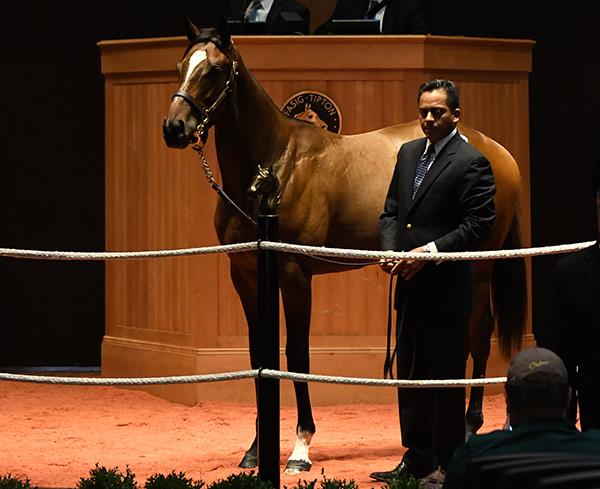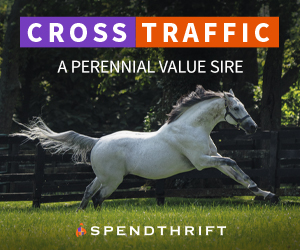
By Steve Zorn
With the end of the Fasig-Tipton Midlantic sale, this year’s yearling auction season is nearly three-quarters of the way done. More than 5800 yearlings have already been through Keeneland’s September extravaganza and Fasig-Tipton’s September and October sales, both of which were rearranged to accommodate the loss of the usual F-T fixtures in July at Lexington and August in Saratoga.
So far, if you’re a breeder, the news isn’t good. Keeneland’s gross, at $249 million, was down nearly a third from last year’s total, with 500 fewer horses actually sold than in 2019. Despite a dozen or so six-figure yearlings, the average price dropped by 20%, from $125,000 in 2019 to just over $100,000 this year. Put those two numbers together, and you get nearly a one-third decline in the gross proceeds, from $372 million last year to just $249 million in 2020. True, a number of yearlings were sold right off the farms in Kentucky, but there’s something like $125 million that won’t be going to breeders (and, in a lesser way, to consignors and to Keeneland itself) to pay the coming year’s stud fees and expenses.
Some of that shortfall reflects the earlier bad news from this year’s two-year-old sales, badly disrupted by the COVID-19 pandemic. Those sales left breeders and, especially, pinhookers, some $60 million short of where they had been a year ago, and some of that shortage was reflected in Keeneland September, where pinhookers usually stock up for next year. But the falling-off in demand at Keeneland went beyond the pinhookers’ woes; except at the very top of the market, buyers just weren’t willing to spend as much.
Looking at Fasig-Tipton, things get a little more complicated. In a normal year, F-T runs six separate yearling sales: a July new-sire showcase, “select” and NY-bred sales at Saratoga, regional auctions in California (just added to the calendar last year) and Timonium, MD, and a big last-chance October sale in Lexington. The last few years, the catalogs for all those sales combined offered about 3,000 horses – not as big as Keeneland September, but still a big chunk of the market. This year, with no sales in July and nothing happening at Saratoga, F-T was forced to improvise. The company combined all its early sales into two auctions, a Lexington “showcase” and an enlarged Timonium sale, each with a specific part of the catalog set aside for NY-breds. As of now, the California sale and the end-of-season Lexington event are still to come.
The best way to look at the Fasig-Tipton results is to pull out the NY-breds from the Lexington and Timonium catalogs and look at them separately, as a rough comparison with the Saratoga NY-bred auction that didn’t happen this year. There were 164 NY-bred yearlings offered in Lexington at the “showcase,” and another 154 at Timonium, for a total of 318; that’s very close to the number of horses in the Saratoga NY-bred sale catalogs the last couple of years. So, how’d they do?
In 2018 and 2019, F-T’s Saratoga NY-bred sale grossed $18.5 million and $16.2 million, respectively. This year, the equivalent horses, at the front of the Lexington and Timonium catalogs, brought in just over $7,750,000, a decline of more than 50% from last year’s total. It’s going to be a long winter for New York breeders. And that’s not because a lot fewer horses were sold. This year, 160 of those 318 NY-breds in the catalogs sold, compared to 186 in 2019 and 172 in 2018 at the Saratoga state-bred auctions. It wasn’t that buyers didn’t want horses; they just didn’t want to pay a lot for them, so the average price dropped 44% from last year, to $48,450.
Fasig-Tipton fared slightly better with the non-NY yearlings it sold this year. Of the 917 catalogued at Lexington and Timonium, 567 were sold, for a total of $63.1 million, an average of $111,265. Last year, at F-T’s July, Saratoga Select and Timonium sales, there were 1,023 yearlings in the catalogs, of which 637 sold for a gross of $81.4 million and an average of $127,786. So, fewer horses sold this year, with a somewhat lower average price, resulting in a gross that’s $18 million short of last year’s total.
Still to come, assuming no COVID-19 October surprise, are F-T’s Santa Anita and Lexington sales this month, as well as the Ocala Breeders Sales Co. yearling sale. Last year, those three sales catalogued 2,522 horses, of which 1,542, or roughly two-thirds, were sold, generating total proceeds of $51 million. This year, there are 2,442 yearlings in the catalogs. If this year’s pattern holds true for the remaining sales, they’re likely to generate somewhere between $35 million and $40 million at most, and less than that if the Keeneland figure of a 33% drop applies.
Adding it all up, that’s a $125 million shortfall from Keeneland, $26 million from the Fasig-Tipton sales to date, and, let’s say, an estimated $15 million from the remaining sales. In round numbers, that’s $165 million that breeders had last year that they won’t have this year going forward into the 2021 breeding season. Many of them will be forced to respond by cutting back on the number of mares they’ll send to the breeding shed. The foals that aren’t conceived next year will be the ones that aren’t born in 2022, when we can expect the North American foal crop, already down 60% from its mid-1980s high and over one-third from its level just before the 2008 financial crash, to crash through the 20,000 level on its way even further downward.



